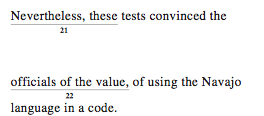
Nobody likes commas: they're weird and confusing and possibly pointless. My brother decided to boycott them entirely in his senior year of high school, leaving his lists running together and his appositives undefined. Even veteran copy editors sometimes struggle with where exactly to place these reviled punctuation marks.
Even so, if you want to succeed on the ACT English, you'll have to learn how to expertly employ commas. The good news is that there is a fairly limited set of comma rules you'll need to know for the ACT. But before we get into the nitty-gritty technical stuff, let's establish one very important principle.
Here's an overview of what we're going to cover:
- The Single Most Important Rule About Commas
- 4 Key Rules for Comma Use on the ACT
- When NOT to Use a Comma
- Practice Questions
When in Doubt, Leave It Out!
This is the single most important rule to keep in mind when dealing with commas on the ACT: if you aren't sure if you need a comma, you probably don't need a comma. In fact, you're far more likely to miss a question because you add in an unnecessary comma than you are to miss one because you left an important comma out. Take a look at the following ACT questions:


Though it may be tempting to leave a comma after "value" or put one after "officials," the sentence is perfectly clear without either: Nevertheless, these tests convinced the officials of the value of using the Navajo language in a code. (H is thus the correct choice.) This principle holds for the next example as well:

Write this sentence out with no commas and you get "Perhaps this legacy of letters explains what she meant when she said that her friends were her 'estate.'" Again, it makes sense without either comma, so D is the correct choice.
Unfortunately as much as we may wish that we could just stop using commas altogether, there are certain times that they're necessary. The following four rules will help you determine when and where you need to place commas.

An example of an extremely vital comma.
4 Key Rules for Comma Use on the ACT
The basic purpose of commas is to clarify relationships between phrases and clauses. That's a pretty broad goal, and there are a lot of different uses for commas.
Luckily, you only really need to focus on a few main rules in order to do well on the ACT. The four rules you absolutely have to know deal with modifying phrases and clauses, introductory phrases and clauses, connecting independent clauses with a conjunction, and separating items in a list. Don't worry if that all sounds like gibberish: we'll go over each case with examples!
Appositives, Relative Clauses, and Interjections
As a general rule, any part of a sentence that can be removed without changing the sentence's fundamental meaning must be bracketed by commas. Take, for example, the following sentence:
Timmy who loves Superman is excited for the upcoming movie.
The point of the sentence is that Timmy is excited about the movie—his love of Superman is just helpful background info. Since taking out "who loves Superman" wouldn't affect the main idea of the sentence, that clause needs to be separated from the rest of the sentence by commas, like so:
Timmy, who loves Superman, is excited for the upcoming movie.
If you aren't sure whether a part of a sentence needs to be surrounded by commas, try crossing it out. If the sentence still makes sense, then the commas are needed; if it doesn't, then they aren't. Let's try it out with an example:
The student who forgot her homework got detention.
"Who forgot her homework" seems like it might need to be set off with commas, so let's cross it out and try reading the sentence again:
The student who forgot her homework got detention.
With that clause crossed out, it's no longer clear which student got detention, so by removing it we have changed the meaning of the sentence. This means that it shouldn't be surrounded by commas.
With these general principles in mind, let's examine the three main cases, which—as you may have guessed from the title of this section—are relative clauses, appositive phrases, and general interjections.
Relative Clauses: Non-Restrictive vs. Restrictive
Relative clauses are dependent clauses that describe a noun and start with a relative pronoun or adverb like "which," "that," or "where." If you're not sure exactly what those terms mean, don't worry about it too much but consider checking out our guide to clauses.
The rule for using commas with relative clauses is that you don't use commas around a clause if it's restrictive, i.e. it clarifies the specific thing you're talking about, but you do use commas if the clause is non-restrictive, i.e. it merely comments on a clearly defined noun. This may seem confusing, but it's much clearer in practice, so let's look at the two types of clauses individually.
Restrictive: These are clauses that are necessary to the meaning of a sentence—they clarify exactly who or what you're talking about. You can't take a restrictive clause out of a sentence without fundamentally altering its meaning. Take a look at the example below.
People who dislike kale won’t enjoy green smoothies.
In this sentence, if you take out the clause “who dislike kale,” you’re left with “People won’t enjoy green smoothies,” which is not making the same point as the original sentence. Because this kind of clause can't be removed without changing the meaning of the sentence, it should not be marked off with commas.
Non-Restrictive: These are clauses that provide additional information and are therefore not integral to the meaning of the sentence.
My sister, who dislikes kale, doesn’t enjoy green smoothies.
The point of this sentence is that my sister doesn’t enjoy green smoothies; even if you remove the underlined portion, that point is still made. Unlike in the example of a restrictive clause above, the underlined portion is not vital to meaning of the sentence. As such, it needs to be separated from the main thought of the sentence with commas.
An important point for the ACT: clauses starting with "which" are always non-restrictive, while those starting with "that" are always restrictive. This means that "which" ALWAYS takes a comma and "that" NEVER does:
I love reading books that are full of adventure because they take me away from my boring life.
I love Harry Potter and the Sorcerer's Stone, which is full of adventure, because it takes me away from my boring life.

The lovely comma butterfly (© Michael Palmer)
Appositive Phrases
Appositive phrases are basically the grammatical younger sibling of descriptive clauses: they serve the same purpose, describing a noun or pronoun, but they don't include a verb. Nonetheless, the basic rule for comma use is identical. If a phrase can be removed without changing the meaning of the sentence, it needs to be surrounded with commas. Consider the following examples. Where do you think they need commas?
Her mother a doctor was often late. → Her mother, a doctor, was often late.
Jonah a fifth-grader jumps rope on the playground everyday. → Jonah, a fifth-grader, jumps rope on the playground everyday.
The nouns "a doctor" and "a fifth-grader" modify "her mother" and "Jonah," respectively, but they aren't necessary to main gist of the sentences.
The one slightly confusing spin on this rule is that when the order of appositives are reversed, they usually don't require commas anymore.
Ernest Hemingway, an author, wrote nine novels.
Ernest Hemingway an author wrote nine novels.
In the above example, we employ our strikethrough strategy and determine that the commas are appropriately placed. However, when we reverse the word order below, you'll notice a change.
Author Ernest Hemingway wrote nine novels.
Author Ernest Hemingway wrote nine novels.
Even though "author" now comes first, it's still modifying "Ernest Hemingway." This means that "Ernest Hemingway" shouldn't be set off with commas; as you can see, the sentence wouldn't make sense with his name removed. Moreover, tempting as it may be to put a comma after "author," it's actually serving as an adjective in this context. Just like you wouldn't put comma in the middle of "President Barack Obama," you shouldn't stick one in "Author Ernest Hemingway."
Interjections
The last case we'll discuss is interjections, which are words or short phrases that disrupt the flow of a sentence like "of course." We tend to use these a lot more when we speak than when we write, but they do pop up on the ACT occasionally. What you are more likely to see is the related construction that occurs when a transition word is moved into a sentence, like in the following example.
Version 1: However, my sister refused to help me move the couch.
Version 2: My sister, however, refused to help me move the couch.
The second type of sentence structure appears relatively frequently on the ACT—just know that if you see a transition word interrupting a clause, it needs to be set off with commas.
We've covered a lot of information and it may seem really complicated, but the important thing is to remember the fundamental principle: if something is surrounded by commas, then it isn't important to the main point of the sentence.
ACT Applications
ACT questions about appositives and relative clauses usually require you to determine whether you need a comma to complete a pair and, if so, where it needs to go.


Let's go through the question step by step. As written, this sentence doesn’t have a main verb—it’s just a subject, “Houdini,” followed by a long non-restrictive clause—so F can't be correct. J doesn’t solve this problem. G and H both place a comma after spiritualism, which gives you the non-restrictive clause “who devoted considerable effort to exposing hoaxes involving spiritualism.” If you cross that out, you’re left with either:
G) Houdini, who devoted considerable effort to exposing hoaxes involving spiritualism, being skeptical about the existence of spiritualism.
or
H) Houdini, who devoted considerable effort to exposing hoaxes involving spiritualism, was skeptical about the existence of supernatural beings.

Introductions
Now that we've covered when to use commas to with phrases and clauses inside the main clause of a sentence, let's discuss when you need commas to separate clauses and phrases that come at the beginning of a sentence. The short answer? Always. The basic rule for using commas with introductions is that any time a sentence starts with a dependent clause or modifying phrase, it must be followed by a comma:
Even though I was tired, Jenny convinced me to go to the strawberry festival.
In the library, she found the books she needed.
Weird-looking as it was, the lizard was sort of cute.
In each of these examples, the underlined portion serves to introduce an independent clause. Weirdly, if you reverse the order of the sentence, you usually don't need the comma any more:
Jenny convinced me to go to the strawberry festival even though I was tired.
She found the books she needed in the library.
The third example sentence is a slightly different case, since you can't actually put the underlined clause at the end of the sentence—it's a modifier and thus needs to be next to what it's describing, which in this case is the lizard. You can, however, move it into the sentence:
The lizard weird-looking as it was was sort of cute.
Any idea what this version of the sentence is missing? That's right: a comma on either side of "weird-looking as it was," which could be removed without fundamentally altering the meaning of the sentence. The correctly punctuated version looks like this:
The lizard, weird-looking as it was, was sort of cute.
ACT Applications
The ACT rarely tests the introduction rule directly; instead, you'll usually see it come up in questions that have multiple phrases or clauses strung together. Take a look at the following example:

"The next morning" is an introductory phrase, so it must be followed by a comma—this rules out answer D. Answer choice C has an improperly placed semi-colon, so we can eliminate it as well. (For more info on semicolon rules, check out our post on other punctuation!) Now we just have to decide whether the commas should surround "using twigs" or "using twigs for kindling." Let's try each version with our strikethrough strategy from the last section.
A. The next morning, using twigs, for kindling she starts a small blaze
B. The next morning, using twigs for kindling, she starts a small blaze
Answer B is clearly the correct choice, since it correctly punctuates both "the next morning" and "using twigs for kindling." When dealing with commas, always remember that when you surround something with commas, you're telling the reader that it can be removed without altering the main point of the sentence.
Connecting Independent Clauses (with a Conjunction)
The other main case where you need commas to separate clauses is when you use a coordinating conjunction to connect independent clauses. If you have two independent clauses and want to combine them into one sentence, you can use a comma and a coordinating conjunction, or FANBOYS (for, and, nor, but, or, yet, so), instead of a semicolon. You probably use this construction correctly all the time without even thinking about it!
I wanted to go hiking, but it was pouring rain all day.
The important thing to remember is that using just a comma (no FANBOYS) to connect two independent clauses is absolutely always incorrect. A comma isn't interchangeable with a semicolon. This mistake is called a comma splice, and it's one of the most common errors students make on the ACT English.
Incorrect: I had a terrible case of the flu, my mom brought me chicken noodle soup in bed.
Correct: I had a terrible case of the flu, so my mom brought me chicken noodle soup in bed.
Correct: I had a terrible case of the flu; my mom brought me chicken noodle soup in bed.
ACT Applications
On the ACT, this comma rule is usually tested in the context of other types of punctuation or in terms of identifying independent and dependent clauses. For more information on this, see our post on correctly connecting independent clauses.
Lists
The last comma rule is likely the one you're most familiar with: in lists of three or more items, you must place a comma after every item except the last. It's really as simple as that, as you can see in the examples below.
The pirate loves going to Barbados because there's so much to do, including shopping for eye patches, sharpening his sword, and visiting the pub.
Today, I'm going to skip school, go to the movies, and eat a giant bag of popcorn.
Note that on the ACT you must use the oxford, or series, comma, which goes before the "and."
 You may not like the Oxford comma, but you still have to use it.
You may not like the Oxford comma, but you still have to use it.
Lists of Two Items
The ACT writers won't give you a bunch of lists with no commas in them—instead they'll try to trick you in subtler ways. After looking at the last two rules, you might assume that you need to put a comma anywhere you see "and," but that's not the case! If "and" (or any other coordinating conjunction) is connecting two things that are not independent clauses, then you DON'T use a comma.
James and his brother traveled to Oregon and Washington.
The ACT writers' other favorite trick is to give you lists that don't look like lists because each item is so long.
Yesterday, Talia went on a boring first date that she left early and plotted to take over the world using nothing but duct tape and string.
You don't need commas in either of these cases because they are lists of only two items.
Lists of Adjectives
This is a slightly different type of list, but it does come up on the ACT occasionally. If you have more than one adjective in front of a noun or pronoun and their order doesn't matter, then you need to put a comma between them. Let's look at two examples, one where you need a comma and one where you don't:
The hot dry desert
The first female astronaut
Which one do you think needs a comma? If you're not sure, check whether the examples make sense with the order of the adjectives reversed:
The dry hot desert
The female first astronaut
The first example makes perfect sense with the new word order, so it does need a comma: the hot, dry desert. The second, however, doesn't work when the order of the adjectives is switched, so no comma is needed: the first female astronaut.
ACT Applications
As I mentioned above, ACT questions about lists tend to try to throw you off by adding in complicating factors like lots of extra words or commas being used for another purpose. Let's take a look at an example of this:


It may seem like you need a comma after "labor," but this sentence is actually correct as written. It is a list of two things: "of her labor" and "of the fire's magic." A, no change, is the correct choice; the other answers only complicate the sentence. (This question also deals with parallelism, which you can learn more about here.) Remember the fundamental rule of commas: when in doubt, leave it out!
When NOT to Use a Comma
We just spent a long time going over when you do need commas, so let's circle back to that first principle by examining some places where you should NEVER put commas.
Between a Subject and a Verb
Commas exist to clarify the relationships between clauses and phrases, so it is NEVER correct to stick one in the middle of a single thought. Any sentence where there is a lone comma between a subject and its verb is incorrect:
Incorrect: She, ate a lot of cookies.
Correct: She ate a lot of cookies.
In the above example, the comma is pretty clearly out of place, but that isn't always the case:
Incorrect: Walking to the store, was a chore.
Correct: Walking to the store was a chore.
Once again, the comma is unnecessary and should be removed: "walking" is the subject and "was" is the verb. But it's much less obvious, since it seems like "walking to the store" is an introductory phrase, which would require a comma.
Before or After a Preposition
Another place you may think you need commas is at the beginning of prepositional phrases; after all, I just said that commas should only be used to seperate clauses and phrases. However, on the ACT, it is NEVER correct to place a comma after a preposition and very rarely correct to place one before a preposition. Let's look at some example of incorrect comma placement:
Lucy enjoys reading aloud, from Harry Potter every night.
Jim watched the terrifying horror movie, in the new theater on, 2nd Avenue.
Though these commas may seem correct, they are unnecessary and just add clutter to the sentences. The correctly punctuated versions have no commas:
Lucy enjoys reading aloud from Harry Potter every night.
Jim watched the terrifying horror movie in the new theater on 2nd Avenue.
The one, very rare, exception to this rule is when a preposition introduces a non-restrictive clause. For example:
Julie, for whom I was waiting, got to the restaurant very late.
Because "for whom I was waiting" is actually non-restrictive clause, you do need the comma before "for." However, this only rarely comes up on the test—you are much more likely to make a mistake by putting a comma in front of a preposition than by leaving one out.
Around an Emphatic Pronoun
What on earth, you're wondering, is an emphatic pronoun? The emphatic pronouns are myself, yourself, herself, himself, itself, ourselves, yourselves, and themselves when they are used immediately after a noun or other other pronoun:
I myself
The book itself
These constructions sound like they need commas, but emphatic pronouns should never be surrounded by commas.
Incorrect: The pope, himself, will be at the party.
Correct: The pope himself will be at the party.
This may seem like a fairly obscure rule: it is! However, it shows up on the ACT fairly often, so it's worth studying anyways.
 To comma or not to comma? That is the question (© Placbo)
To comma or not to comma? That is the question (© Placbo)
Try Your New Knowledge Out!
We've covered a lot of material and hopefully armed you with some helpful new strategies for tackling commas on the ACT English, but it's one thing to read about comma rules and another to put them in practice. With that in mind, I've created some practice ACT questions for you test out what you've learned.
- The soft, blue cloth slid through her fingers easily.
- NO CHANGE
- blue, cloth slid through
- blue cloth slid, through
-
blue cloth, slid through
- After hearing good things about it, I wanted to read Crime and Punishment, but the book, itself, turned out to be super boring.
- NO CHANGE
- the book itself,
- the book itself
-
itself
- Talking to my friends, on the phone, is one of my favorite things to do.
- NO CHANGE
- friends on the phone
- friends on the phone,
-
friends on, the phone
- I wasn't planning on going to the wedding, however you've convinced me that it's a good idea.
- NO CHANGE
- wedding, however,
- wedding. However,
- wedding,
Answers: 1. A, 2. C, 3. B, 4. C
What's Next?
If you're confused about what exactly is tested on ACT English, take a look at our guide to what's actually on the test. You might be surprised by how much of it we've just covered!
Looking to score a 36 on ACT English? Check out 9 strategies from someone who achieved a perfect score on the ACT.
Maybe you're now feeling okay about punctuation, but are worrying about vocab questions. In that case, have I got the guide for you!
Because ACT English recycles the same types of questions over and over, it's especially important to understand why you missed a given question. Make sure you're reviewing your practice tests effectively.
Want to improve your ACT score by 4 points?
Check out our best-in-class online ACT prep classes. We guarantee your money back if you don't improve your ACT score by 4 points or more.
Our classes are entirely online, and they're taught by ACT experts. If you liked this article, you'll love our classes. Along with expert-led classes, you'll get personalized homework with thousands of practice problems organized by individual skills so you learn most effectively. We'll also give you a step-by-step, custom program to follow so you'll never be confused about what to study next.
Try it risk-free today:
Have friends who also need help with test prep? Share this article!

Alex is an experienced tutor and writer. Over the past five years, she has worked with almost a hundred students and written about pop culture for a wide range of publications. She graduated with honors from University of Chicago, receiving a BA in English and Anthropology, and then went on to earn an MA at NYU in Cultural Reporting and Criticism. In high school, she was a National Merit Scholar, took 12 AP tests and scored 99 percentile scores on the SAT and ACT.


































 Holly R.
Holly R.